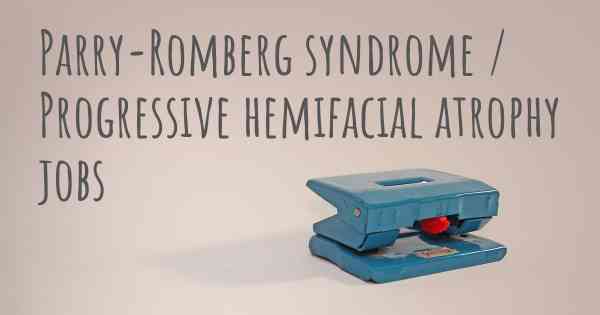Can people with Parry-Romberg syndrome / Progressive hemifacial atrophy work? What kind of work can they perform?
See how people with experience in Parry-Romberg syndrome / Progressive hemifacial atrophy give their opinion about whether people with Parry-Romberg syndrome / Progressive hemifacial atrophy can work and what kind of jobs are more appropriated for people with Parry-Romberg syndrome / Progressive hemifacial atrophy

Can people with Parry-Romberg syndrome / Progressive hemifacial atrophy work?
Parry-Romberg syndrome, also known as progressive hemifacial atrophy, is a rare disorder characterized by the progressive wasting away (atrophy) of the tissues on one side of the face. This condition typically begins in childhood or adolescence and can continue to progress over several years. As the condition affects the physical appearance of individuals, it may raise concerns about their ability to work and perform certain tasks.
Employment Opportunities
People with Parry-Romberg syndrome can certainly work and contribute to the workforce, although the specific type of work they can perform may vary depending on the severity of their condition and any associated complications. It is important to note that individuals with Parry-Romberg syndrome have unique abilities, skills, and qualifications that can be valuable in various professional settings.
Physical Limitations
Parry-Romberg syndrome primarily affects the face, causing facial asymmetry and tissue loss. While the physical changes can be significant, they do not typically impact an individual's overall physical abilities or cognitive function. Therefore, many individuals with Parry-Romberg syndrome can perform a wide range of jobs that do not require specific facial functions or symmetry.
Office-Based Jobs
Office-based jobs are often suitable for individuals with Parry-Romberg syndrome. These roles involve tasks such as administrative work, data entry, customer service, project management, and more. These positions rely more on skills such as communication, organization, problem-solving, and teamwork rather than physical appearance.
Artistic and Creative Fields
Many individuals with Parry-Romberg syndrome possess exceptional artistic and creative abilities. They may excel in fields such as painting, drawing, graphic design, photography, and writing. These professions allow individuals to express their creativity and talent without being hindered by their physical appearance.
Technology and IT
The technology and IT industry offers numerous opportunities for individuals with Parry-Romberg syndrome. Roles such as software development, web design, programming, data analysis, and technical support often focus on skills and knowledge rather than physical appearance. These jobs can be performed remotely or in an office environment, providing flexibility and inclusivity.
Entrepreneurship
Some individuals with Parry-Romberg syndrome may choose to pursue entrepreneurship. Starting their own business allows them to create a work environment that accommodates their specific needs and abilities. They can leverage their unique experiences and perspectives to develop innovative products or services.
Supportive Work Environments
Creating a supportive work environment is crucial for individuals with Parry-Romberg syndrome. Employers and colleagues should be educated about the condition to foster understanding and empathy. Workplace accommodations, such as flexible schedules, modified workstations, or remote work options, can help individuals with Parry-Romberg syndrome thrive in their chosen careers.
Conclusion
People with Parry-Romberg syndrome can indeed work and contribute to various industries and professions. While the physical changes caused by the condition may present challenges in certain fields, there are numerous job opportunities that focus on skills, qualifications, and creativity rather than physical appearance. With the right support and accommodations, individuals with Parry-Romberg syndrome can lead fulfilling and successful careers.
Posted Mar 4, 2017 by Hannah 1050
Posted Mar 4, 2017 by Barbara 1000
Posted Mar 6, 2017 by Caroline 200








